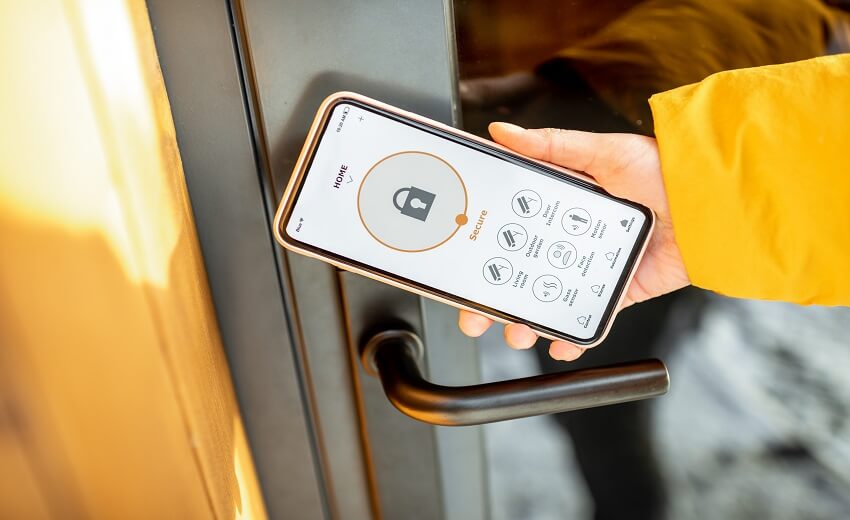Locks are indispensable items in residential properties. Increasingly, mechanical locks have given way to electronic, smart locks that bring various benefits to residents. This note discusses the latest trends and what to look for in smart locks.
Smart locks are BLE- or Wi-Fi-enabled devices that allow residents to leave mechanical keys behind, locking and unlocking doors with the touch of a finger or tap of a smartphone. Growth is also seen in this sector. According to Grand View Research, the global smart lock market was valued at US$1.38 billion in 2020 and is expected to grow at a compound annual growth rate of 21.4 percent from 2021 to 2028.

A smart lock will help you to get into your house with ease. Generally, people waste a lot of time looking for their keys. With a smart lock, you can get into your home with a few touches of your phone. Smart locks also come with several benefits, including Wi-Fi, Bluetooth, and August.
Wi-Fi
Wi-Fi smart locks work by connecting to your home Wi-Fi network. They connect over a Z-Wave hub that can also be connected to other smart devices. Some Z-Wave smart locks can be retrofitted so that you can keep your existing deadbolt while installing a new one.
Wi-Fi smart locks can be controlled remotely with a Wi-Fi connection. They can also alert you when someone tries to enter and exit your home. Moreover, you can even configure them to work only during specific hours.
Bluetooth
Most smart locks that work with Apple HomeKit use Bluetooth to communicate. Most of these devices also have their own app that users can use to control them. The technology allows them to unlock and lock doors with a simple tap. Some of them also use proximity detection to unlock the door when you’re close. Other models allow you to use your smartphone as a key to unlock the door when you’re out of the house.
Bluetooth is a great option for smart locks because it requires less infrastructure than Wi-Fi. Bluetooth smart locks typically have a range of about 150 feet, and you need to be within range of the device to unlock it. They are energy-efficient, too, meaning they require minimal maintenance.
Z-Wave
Unlike Bluetooth-enabled smart locks, Z-Wave smart locks need additional hardware to talk to Wi-Fi. In addition, they require more battery power and require more frequent updating. And unlike Bluetooth, Z-Wave smart locks require a separate hub for communication, such as SmartThings.
The battery life of Z-Wave smart locks depends on several factors, including usage frequency and door condition. For instance, a Kwikset SmartCode 910 Z-Wave smart lock can last between 1.5 and two months. Using cheap batteries will cause you to replace the battery too frequently.
August
To get the most out of your August Smart Lock, you need to know how to install it properly. August provides installation guides and get-started guides for most of its products. Follow the instructions carefully to ensure that your August Smart Lock works properly. Once installed, you can use the August Home app to manage your lock.
August’s Smart Lock Pro has a number of features. It can be used as a standalone device or connected to a Z-Wave hub. The smart lock Pro can function as a standalone doorbell as well. If you don’t want to buy the bridge separately, you can get the August Smart Lock Pro + Connect bundle, which includes the WiFi bridge and lock. With these options, you’ll have everything you need for a fully-connected home.
ZKTeco
If you’re planning to install a ZKTeco smart lock in your home, you’ll want to know how to smartly select and install it. You can install this smart lock on doors and use an app to calibrate it. There are also paper manuals that explain how to install the lock.
If you’re installing the ZKTeco Smart Lock Pro on a door, you’ll have to remove the existing deadbolt thumbturn and additional back plate, and install the ZKTeco smart lock. After removing the existing deadbolt, you’ll want to position the thumbturn so you can access the screws. Installing the ZKTeco smart lock requires two screws, one for the mounting plate and one for the thumb-latch.
Kwikset
The Kwikset smart lock features a capacitive touch screen keypad, and is easy to unlock with the touch of a finger. The screen, however, has a few drawbacks, such as a lack of visibility in direct sunlight. It is also hard to unlock the door without pushing the screen hard. If you are having trouble unlocking the door with the touch screen, you can simply hit the lock button instead.
Kwikset smart door locks are simple to install and offer a wealth of security features. They can be installed in as little as 20 minutes, and do not require complicated wiring. Another advantage of these locks is their ability to be rekeyed, meaning they do not need to be replaced or customized if a key is lost or stolen.